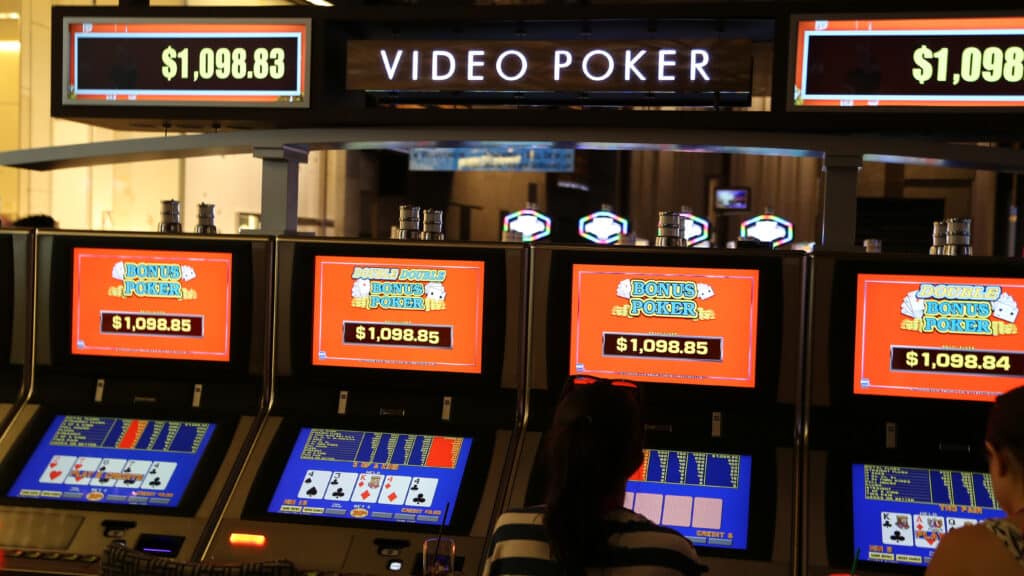Video poker, a captivating blend of chance and skill, has journeyed from the rudimentary mechanics of early gambling devices to the sophisticated algorithms of online casinos, becoming a global phenomenon in the process. This detailed article delves into the historical overview of video poker development, charting its evolution, key milestones, and enduring appeal to a diverse spectrum of players.
Mechanical Ancestry: Precursors to the Electronic Age
Before the glow of video screens, the spirit of video poker was kindled in the late 19th century through purely mechanical inventions. In 1891, the Brooklyn-based company Sittman and Pitt created a machine that, while not strictly video poker, embodied its foundational concept. This device featured five rotating drums, each adorned with 50 playing cards – notably omitting the Jack of hearts and ten of spades to subtly reduce the odds of a royal flush. Players inserted a nickel and pulled a lever, setting the drums in motion to reveal a poker hand.
These early poker machines, distributed across bars in New York, offered a novel form of automated gambling. Winning combinations, lacking automated payouts, were often redeemed at the bar for prizes like free drinks, cigars, or food. The social element of claiming prizes from the bartender added a unique dimension to the solitary act of machine play. Variations on this mechanical theme emerged, including machines using poker dice, further illustrating the burgeoning interest in automated poker-style games. These mechanical ancestors, though limited in complexity and lacking the draw feature central to modern video poker, were crucial in establishing the public's fascination with machine-based poker and set the stage for the electronic revolution to come.
The Electronic Dawn: Fortune Coin and the Video Poker Revolution (1970s)
The 1970s marked a watershed moment, as electronic technology began to permeate casino gaming. This decade witnessed the birth of true video poker, merging television display technology with the established appeal of poker-based gambling. In 1970, Dale Electronics unveiled 'Poker-Matic', an electromechanical device often credited as the first electronic poker game. While still incorporating mechanical components, 'Poker-Matic' utilized electronic circuits to manage gameplay and payouts, representing a significant step towards full electronic video poker.
However, it was Fortune Coin Co. in 1975 that achieved the true breakthrough. Led by Walt Fraley, they ingeniously combined a modified 19-inch Sony Trinitron color television receiver with logic board technology to create a fully electronic video draw poker game. This innovation replaced mechanical reels with a video screen displaying cards, offering greater flexibility in game design and visual appeal. Initially tested at the Las Vegas Hilton, this unnamed machine, soon dubbed "Video Poker", proved to be an instant hit with players. Its success stemmed from several factors: the familiar poker hand rankings, the engaging video display, and the faster pace of play compared to mechanical slots.
Si Redd, then a Bally Technologies distributor, recognized the immense potential of Fortune Coin's invention. He negotiated a deal to distribute and eventually acquire Fortune Coin, bringing video poker under the umbrella of a major gaming manufacturer. In 1979, under IGT (International Game Technology), now headed by Redd after the Fortune Coin acquisition, "Draw Poker" was released, a refined and commercially successful version of the original Fortune Coin machine. Crucially, the Nevada Gaming Commission granted regulatory approval to video poker, legitimizing it as a bona fide casino game and paving the way for its widespread adoption across Nevada and beyond. The late 1970s thus witnessed not only the technological invention of video poker but also its successful integration into the established casino industry, setting the stage for its explosive growth in the 1980s.
The 1980s: Expansion, Game Variations, and Strategic Depth
The 1980s were pivotal for video poker, witnessing its transformation from a casino novelty to a mainstream gambling attraction. This decade was characterized by rapid technological advancements, the emergence of iconic game variations, and the development of strategic play.
IGT, under Si Redd's leadership, dominated the burgeoning video poker market. Their introduction of "Jacks or Better" in the early 1980s proved to be a masterstroke. This variant, with its simple premise of paying out for hands of a pair of Jacks or higher, became the bedrock of video poker. The pay table for "Jacks or Better," particularly the "full pay" 9/6 version (9 coins for a full house, 6 for a flush), offered a relatively high return to player (RTP) of approximately 99.5% with optimal strategy. This transparency and favorable RTP, compared to traditional slot machines, attracted a more strategic and discerning player base. The concept of 'full pay' machines became a key differentiator for video poker, emphasizing skill and informed play.
The 1980s also saw the rise of other enduring video poker variations. "Deuces Wild", capitalizing on the wild card concept, introduced twos as wild cards, dramatically altering hand probabilities and optimal strategy. This variant offered the potential for very high-paying hands and a more volatile gameplay experience. "Joker's Wild", using a single Joker as a wild card, provided another layer of variation and strategic nuance. These diverse game types broadened video poker's appeal, catering to different risk appetites and strategic inclinations. Manufacturers like Bally Technologies and Universal Distributing of Nevada also entered the market, contributing to game innovation and market competition.
Technological advancements continued to enhance the video poker experience throughout the 1980s. Color monitors became standard, improving visual appeal. Microprocessors became more powerful and affordable, enabling more complex game logic, enhanced graphics, and improved machine reliability. The shift to solid-state electronics reduced mechanical failures and maintenance costs, making video poker machines more profitable for casinos and more dependable for players. By the end of the decade, video poker had firmly established itself as a core component of the casino gaming landscape, attracting a loyal following and generating substantial revenue.
The Golden Era: Online Expansion and Game Diversification (1990s)
The 1990s ushered in the "golden age" of video poker, marked by its widespread adoption in land-based casinos and its pioneering entry into the burgeoning online gambling industry. This decade saw video poker reach unprecedented levels of popularity and accessibility.
Land-based casinos globally embraced video poker, dedicating increasing floor space to these machines. The variety of games expanded, with multi-hand video poker machines gaining popularity. These machines allowed players to play multiple hands of video poker simultaneously, typically three, five, or ten hands at once, significantly increasing the pace of play and potential for both wins and losses. Multi-hand play catered to players seeking faster action and higher volatility, further diversifying the video poker experience.
The most transformative development of the 1990s was the rise of the internet and online casinos. Video poker was among the vanguard of casino games to transition to the online realm. Early online casinos, emerging in the mid-1990s, recognized the appeal of video poker and offered digital versions of popular variations like "Jacks or Better" and "Deuces Wild". Online video poker provided unparalleled convenience, allowing players to gamble from the comfort of their homes, at any time of day or night. This accessibility dramatically expanded the player base, reaching individuals geographically distant from land-based casinos or preferring the privacy of online play.
Software developers played a crucial role in the online video poker revolution. Companies like Microgaming and Cryptologic, pioneers in online casino software, developed increasingly sophisticated and user-friendly video poker platforms. Graphics and sound effects improved, mimicking the casino experience. Online platforms often offered more generous payout tables and player bonuses to attract customers in the competitive online market. The online environment also fostered the growth of video poker strategy resources. Websites dedicated to video poker strategy analysis, pay table databases, and optimal play calculators emerged, empowering players to refine their skills and make informed decisions. Progressive jackpot video poker games also became prevalent online, offering the allure of substantial jackpots accessible to a global player pool. The 1990s cemented video poker's status as a leading casino game, both in brick-and-mortar establishments and in the burgeoning online gambling world.
21st Century Video Poker: Mobile Gaming, Skill Emphasis, and Future Innovations (2000s-Present)
Since the dawn of the 21st century, video poker has continued to evolve, adapting to the rapid pace of technological change and evolving player preferences. The rise of mobile gaming, the increasing emphasis on skill-based play, and the exploration of new technologies like VR and AR characterize this modern era.
The mobile gaming revolution has profoundly impacted video poker. Smartphones and tablets became ubiquitous, and video poker apps and mobile-optimized websites made the game accessible to players on the go. Mobile accessibility further democratized video poker, allowing for casual play during commutes, breaks, or leisure time. The convenience of mobile play has broadened the player base, particularly attracting younger demographics accustomed to mobile entertainment.
The focus on skill and strategy in video poker has intensified in the 21st century. The internet provides readily available resources for learning optimal video poker strategy. Websites, strategy charts, video poker simulators, and training software empower players to analyze pay tables, practice optimal decision-making, and understand the nuances of different game variations. "Full pay" machines, particularly 9/6 Jacks or Better and 10/7 Deuces Wild, remain highly sought after by strategic players seeking the best possible odds. The concept of "advantage play," exploiting favorable pay tables, casino promotions, and player rewards programs to gain a statistical edge, has become a niche area of focus for dedicated video poker enthusiasts.
Game variations continue to proliferate in the modern era. Beyond the classic versions, numerous spin-offs and hybrid games have emerged, often incorporating bonus features, multipliers, and unconventional pay tables to offer novel gameplay experiences. Games like "Bonus Poker," "Double Bonus Poker," "Double Double Bonus Poker," and "Triple Play Poker" offer enhanced payouts for specific hands, increasing volatility and jackpot potential. Video poker has also seen integration with other casino game formats, with video poker elements incorporated into slot machines and vice versa, blurring the lines between these categories.
Looking towards the future, video poker is poised for further innovation. Virtual Reality (VR) and Augmented Reality (AR) technologies hold the potential to create immersive and interactive video poker experiences, simulating the atmosphere of a real casino. The integration of social gaming elements, such as multiplayer tournaments and social leaderboards, could further enhance player engagement and community. The ongoing evolution of online gambling regulations will continue to shape the accessibility and reach of video poker globally. Despite the emergence of new forms of online gambling and evolving casino landscapes, video poker's blend of skill, strategy, and accessibility ensures its continued relevance and enduring appeal in the ever-changing world of casino entertainment.
Psychological and Social Dimensions: The Enduring Allure of Video Poker
Video poker's sustained popularity is not solely attributable to its gameplay mechanics; its psychological and social dimensions play a significant role in its enduring appeal. It occupies a unique space in the gambling spectrum, bridging the gap between the solitary nature of slot machines and the more interactive environment of table games.
From a psychological perspective, video poker provides players with a sense of control often absent in purely chance-based games. The decision-making element – choosing which cards to hold and discard – creates an illusion of agency, even though the underlying odds remain mathematically determined. This perceived skill component can be highly engaging and contribute to a feeling of involvement beyond simply pressing a button and hoping for luck. The game's rapid pace and immediate feedback – instant wins or losses – provide a stimulating and potentially addictive experience. The near-miss effect, where players narrowly miss high-paying hands like royal flushes, can further reinforce continued play, fueling the desire to chase elusive wins. However, it is crucial for players to recognize the inherent house edge and practice responsible gambling habits to mitigate potential risks.
Socially, while often played individually, video poker can foster a sense of camaraderie, particularly in land-based casinos. Banks of video poker machines often become informal gathering spots where players exchange tips, celebrate wins, and share experiences. Online platforms, with chat features and multiplayer tournaments, can further enhance the social dimension, creating virtual communities of video poker enthusiasts. While not as overtly social as live poker tables, video poker provides opportunities for interaction and shared experiences, contributing to its broader appeal.
Conclusion: A Legacy of Innovation and Enduring Popularity
The historical overview of video poker development reveals a remarkable journey of innovation and adaptation. From its mechanical precursors to its sophisticated digital present, video poker has consistently evolved to meet changing technological landscapes and player preferences. Its enduring appeal lies in its unique combination of poker strategy, slot machine accessibility, and a favorable return to player (for skilled players on select variations). For gamblers, video poker offers a compelling blend of skill and chance, providing opportunities for strategic play and potentially rewarding outcomes.
As technology continues to advance, the future of video poker promises further exciting developments. The integration of virtual and augmented reality, enhanced mobile platforms, and innovative game variations will likely shape the next chapter in video poker's history. Understanding its rich past not only provides valuable context but also deepens appreciation for this strategically engaging and perennially popular casino game. Whether enjoyed in the vibrant atmosphere of a land-based casino or the convenience of an online platform, video poker remains a dynamic and enduring form of gambling entertainment, offering a unique and compelling experience to players worldwide.
External Resources:



